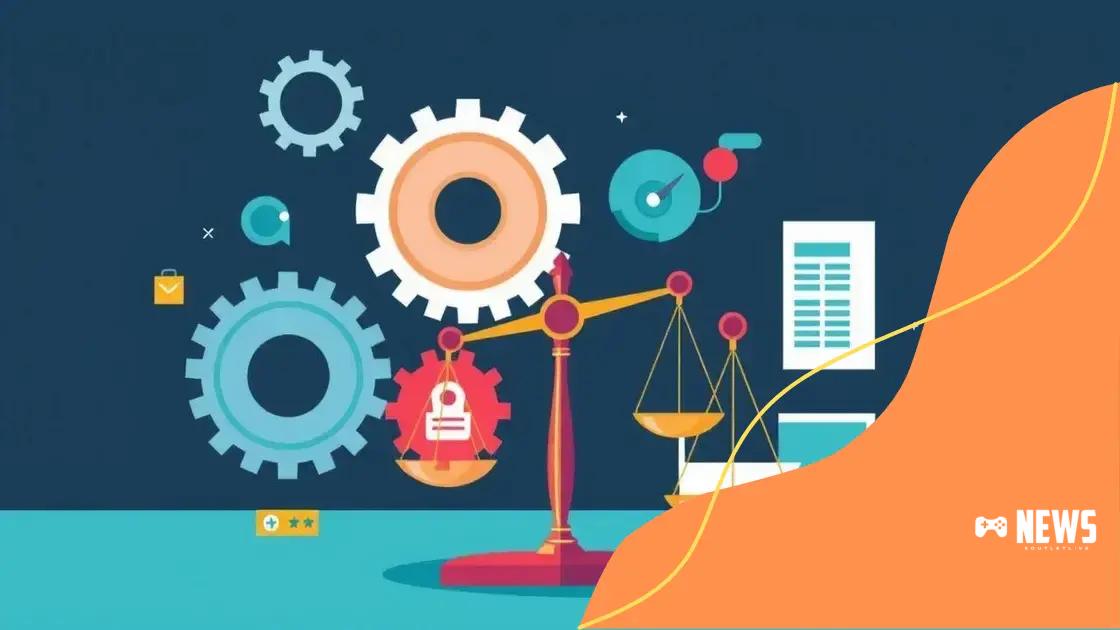Technology company antitrust cases: navigating the legal landscape

Technology company antitrust cases involve legal actions aimed at preventing monopolistic practices, ensuring fair competition, and protecting consumer rights in an evolving digital marketplace.
Technology company antitrust cases have surged in recent years, raising important questions about competition and fairness in the marketplace. Have you wondered how these legal battles impact your favorite tech giants?
Understanding antitrust laws
Understanding antitrust laws is essential for anyone curious about how competition works in the market. These laws are designed to promote fair competition and prevent monopolies. By knowing these rules, companies can operate more effectively.
What are antitrust laws?
Antitrust laws are regulations that encourage competition and prevent unfair business practices. They ensure that no single entity can dominate the market too much. This helps to keep prices fair and innovation flowing.
Key components of antitrust laws
There are several important aspects to consider when discussing antitrust laws:
- Market dominance: This refers to a company controlling a large part of the market.
- Price fixing: This is when companies agree to set prices at a certain level instead of competing.
- Mergers and acquisitions: Antitrust laws often scrutinize large company mergers that could reduce competition.
These laws are enforced primarily by government agencies. They examine business practices to ensure they are not harmful to consumers. If a company is found violating these laws, it may face significant penalties, including hefty fines.
Understanding these laws can empower both businesses and consumers. For businesses, it helps them navigate the market without running into legal troubles. For consumers, it ensures they benefit from fair prices and choices in products and services.
Overall, antitrust laws are critical for maintaining a healthy competitive environment. By preventing monopolies and promoting fair practices, they help create a balanced marketplace.
Recent high-profile antitrust cases
Recent high-profile antitrust cases have drawn significant attention, showcasing how laws impact major technology firms. These cases illustrate the ongoing battle between market dominance and legal restrictions.
Case Examples
Major developments have reshaped the landscape:
- Google: Accused of limiting competition in search and advertising.
- Apple: Faced scrutiny over its App Store practices affecting developers.
- Facebook: Targeted for acquisitions undermining rivals, particularly in social media.
These cases have brought to light the potential consequences for firms that may engage in anti-competitive behaviors. The outcomes are vital not just for the companies involved but also for consumers who rely on fair competition.
Implications for Technology Companies
The implications of these antitrust rulings are far-reaching. Companies must navigate the legal landscape carefully. For instance, firms may need to change their business practices to avoid legal issues. Legal decisions often influence how these companies operate, leading to changes in pricing, marketing strategies, and product offerings.
Moreover, the public and media scrutiny surrounding these cases can impact consumer trust and brand reputation. As more companies find themselves in similar positions, understanding the context of these cases is essential.
The future of the tech industry might hinge on how these antitrust cases unfold. As technology continues to evolve, businesses must adapt to new regulations while maintaining their competitive edge.
Impact of antitrust rulings on technology companies

The impact of antitrust rulings on technology companies is significant and far-reaching. These legal decisions can change how companies operate in competitive markets, influencing everything from pricing to product development.
Business Practices Alterations
After a ruling, companies often reassess their strategies. They may need to alter their business models to comply with the new regulations. This can lead to:
- Changes in pricing strategies: Companies may lower prices to attract customers or innovate products to differentiate from competitors.
- Revised marketing tactics: Businesses might adopt new marketing strategies that align with fair competition guidelines.
- Increased transparency: Companies may enhance transparency to build trust with consumers and regulators.
Adapting to these changes is critical for long-term success while avoiding future legal issues.
Market Dynamics
Antitrust rulings can reshape entire markets. When a large technology company is found guilty of monopolistic practices, other companies may find new opportunities. Smaller firms can enter the market, driving competition and innovation. This competition is beneficial for consumers as it leads to more choices and better services.
Furthermore, consumers benefit from these rulings by enjoying lower prices and higher-quality products. This dynamic can stimulate technological advancements, pushing the industry forward.
In summary, the impacts of antitrust rulings extend beyond immediate legal consequences. They can redefine market landscapes, alter business practices, and engrain a culture of fairness that benefits both companies and consumers.
The role of competition in innovation
The role of competition in innovation is crucial for the growth of technology companies. When companies compete, they push each other to develop better products and services. This drive leads to new ideas and advancements that benefit consumers.
How Competition Sparks Innovation
Competition encourages firms to invest in research and development. Companies know that to stay ahead, they must innovate. Some key ways competition fosters innovation include:
- Increased investment: Companies are more likely to allocate funds toward innovative projects when they are competing for market share.
- Creativity and risk-taking: A competitive environment encourages businesses to take risks with new ideas and technologies.
- Consumer focus: To attract and retain customers, firms must meet consumer demands through innovative solutions.
With these dynamics in play, innovation becomes a vital part of a company’s strategy.
Examples of Innovation Driven by Competition
Several examples demonstrate how competition has driven technological advancements. The smartphone industry, for instance, showcases rapid innovation due to the rivalry between major companies. Each new model introduces enhanced features, setting higher standards for technology. Similarly, software companies are compelled to innovate to offer better services and improve user experience.
Another example is in renewable energy, where competition among firms leads to better and more efficient solutions to tackle climate change. The race to develop superior solar panels or wind turbines sparks creativity and technology breakthroughs.
Ultimately, competition not only benefits the companies involved, but it enriches the market landscape with diverse offerings for consumers.
Future trends in antitrust regulation
Future trends in antitrust regulation are set to shape the landscape of technology firms significantly. As industries evolve, so do the laws governing competition. This evolution is largely driven by advances in technology and changing market dynamics.
Increasing Scrutiny of Big Tech
Regulators are becoming more vigilant about the practices of large technology companies. This includes evaluating how they manage user data and their market influence. Key trends include:
- Data privacy regulations: Antitrust laws may increasingly focus on how companies collect and use personal data.
- Market dominance assessments: Regulators are likely to analyze whether a company’s practices harm competition, not just consumers.
- Global collaboration: Countries may work together to create unified regulations that address antitrust issues on a global scale.
These factors suggest a shift towards more stringent oversight of major technology players.
Emphasis on Consumer Welfare
Another trend is a growing emphasis on consumer welfare. Regulators are rethinking what it means to protect consumers in a competitive market. This could involve defining harm in terms of innovation and choice, not just pricing. For example, if a merger reduces the variety of available products, it could be seen as harmful regardless of price changes.
Moreover, there may be a push for legislation that promotes transparency and fairness in digital platforms. Regulators might seek to ensure that smaller companies can compete effectively against giants by establishing fair practices in the digital marketplace.
The future of antitrust regulation will likely focus on balancing the need for competition with fostering innovation. As technology continues to advance, regulators must adapt their approaches to protect both market dynamics and consumers.
FAQ – Frequently Asked Questions about Antitrust Cases and Technology Companies
What are antitrust laws?
Antitrust laws are regulations designed to promote competition and prevent monopolies in the market.
How do antitrust cases affect consumers?
Antitrust cases help protect consumers by ensuring fair pricing, more choices, and better products.
Why is competition important for innovation?
Competition drives companies to innovate, leading to new products and technologies that benefit consumers.
What trends are shaping future antitrust regulations?
Future trends include increased scrutiny on big tech, focus on data privacy, and global cooperation on regulations.





